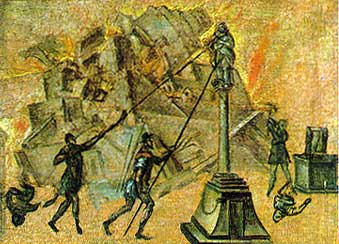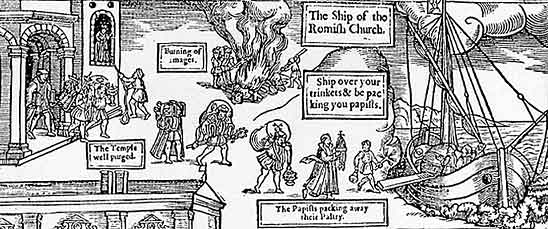|
|
|
|
|
|
|
|
|
|
|
|
|
|
|
|
|
|
|
|
|
|
|
|
|
|
|
|
|
|
|
|
|
|
|
|
|
|
 |
|
|
|
|
|
|
|
|
|
|
|
|
|
|
|
|
|
|
|
|
|
|
|
|
|
|
|
|
 |
|
|
|
|
|
|
|
|
|
|
|
|
|
|
|
|
The
monarchy of Henry VIII had profoundly affected
the traditional workings of the English
Church, however, a strong new religious settlement was not yet in place
upon his demise. At the age of nine, Edward VI inherited a country that was
still divided by religious difficulties. Edward was the only surviving son of
Henry VIII with his third wife, Jane Seymour. There were tendencies towards
Protestantism but the religious sympathies and hopes of the people of England
were still in a state of confusion. Henry VIII's "Boy of wondrous hope"
was still a child and vulnerable to the machinations of the Council of Regency
that was appointed by Henry VIII at his death. Edward VI was dominated first
by his appointed Lord Protectorate of the Realm, the Duke of Somerset (1547-1549)
and later on by the Duke of Northumberland (1549-1553). With the reign of Edward
VI, England experienced a more systematic destruction of images than it had
ever been seen before. Control of the government had fallen to men who were
sympathetic to the Protestant cause and had a strong desire to further the Reformation. |
|
|
|
|
|
|
|
Portrait
of Edward VI emulating the familiar stance of Henry VIII. |
|
|
|
|
|
|
|
|
Thomas
Cranmer still maintained a powerful role as Archbishop of Canterbury and
was charged with compiling the first English prayer book, The Book of Common
Prayer. First published in 1549, it was soon replaced by a version that reflected
stronger Protestant tenants in 1552. Somerset and Cranmer followed the Henrician
settlement on images but things soon accelerated. Cranmer addressed the young
Edward at his coronation, "Your majesty is God's Vice-regent and Christ's
vicar within your own dominions, and to see, with your predecessor Josias, God
truly worshiped and idolatry destroyed, the terrain of the Bishops of Rome banished
from your subjects, and images removed." Cranmer saw images as so tainted
with idolatry that they should be completely eliminated within the realm. The
Archbishop argued that man's willful ways seduce him from truth and are in direct
opposition to God's commandments, which all Christians are compelled to obey.
The Scriptures |
|
|
 |
|
|
|
|
|
|
|
|
|
|
|
Detail
from the Allegory of the Succession of Edward VI depicting soldiers breaking
and burning images. |
|
|
|
|
|
|
|
|
remained the most important criterion for the condemnation of all images. The
second commandment was analyzed and divided into three parts: First that one
should in no way portray God in any graphic or sensual way, secondly honoring
any such representations is forbidden and thirdly that there is no need to represent
God by images as man's worship is essentially spiritual. |
|
|
|
|
|
|
 |
|
|
|
|
|
|
|
|
|
|
|
|
|
|
|
|
During
the reign of Edward VI iconoclastic forces were unleashed that could not easily
be controlled. All images bore the brunt of attack as the desire to abolish
all images took on new political and social import. The destruction that was
carried out was brutal in its excess. With the establishment of the Book of
Common Prayer all images were ordered removed or destroyed Iconoclasm had become
official law by statute. |
|
|
Detail
from the opening page of the Ninth Book on the Reign of Edward VI in John
Foxe's "Acts and Monuments" depicting acts of iconoclasm,
the purging of the temple and the departure of idolatrous Catholics from
England |
|
|
|
|
It
did not make any distinction between acceptable or unacceptable religious image.
Commissioners traveled the land taking inventory and seizing what items were
left in the much abused churches. By Edward VI's death, churches in England
had lost much of the medieval splendor that they had once maintained. Those
objects that were not destroyed were hidden "underground" in the hopes of resurfacing
during reign of the Catholic Queen Mary. |
|
|
|
|
|
|
|
|
|
|
|
|
 |
|
|
|
|
|
|
|
|
|
|
|
|
|
|
|
|
|
|
 |
|
|
 |
|
|
|
|
|
|
|
|
|
|
|
|
|
|
|
 |
 |
 |
 |
 |
 |
 |
 |
 |
 |
 |
 |
 |
 |
 |
 |
 |
 |
 |
 |
 |
 |
 |
 |
 |
 |
 |
 |
 |
 |
 |




